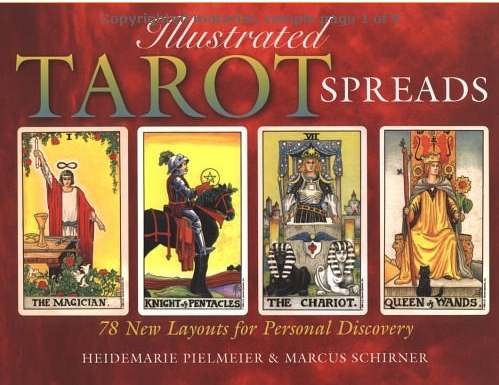|
Tarot Reflections |
August 15, 2003 |
|
Book Review:
Illustrated Tarot Spreads Christopher delaMaison, CPTR |
||||
|
After agreeing to participate in the Free Reading Network, I realized that I still, to a great extent, tend to depend on a limited number of generic spreads to deal with client questions. Working with simple two and three card spreads was something I had done only on trial readings, but never on a continual basis. Having learned the Celtic Cross spread first, I quickly learned how to frame all of my client’s questions with that spread, whether appropriate or not. For myself then, the hurtle to cross was to be able to associate various types of questions with various card spreads. One text, which outlines a wide variety of card spreads and questions they could be used for, is the Illustrated TAROT Spreads, by Heidemarie Pielmeier and Marcus Schirner. This text fills an important gap that occurs in the learning process of the beginning tarot reader. Most beginning tarot classes focus on tarot card care and handling, card interpretations, basic spreads (such as the Celtic Cross), and perhaps tarot history. What is often times lacking is information on how to make that critical jump from constantly using the first successfully learned card spread, to using spreads that allow the reader to explore a client’s question without being bound by unnecessary framing. Having a guide to refer to for a variety of spreads gives a beginner the option to explore new spreads, in an effort to deal with a wider range of client questions. As a new reader gains experience, he/she learns that such spreads can be (and almost always are) adapted to serve for a wider variety of questions. Eventually, the experienced reader may create card spreads that he/she can use to quickly and accurately address their client’s questions. The trick to starting this learning process is to kick the habit of using that original card spread, and to make the deliberate effort to expand one’s repertoire of tarot spreads. To help the reader facilitate this process, Pielmeier and Schirner have put together a deceptively simple book, which sports some 78 card spreads and associated questions. The book is a paperback, laid out in a landscape format, that is 96 pages long, with 78 pages being devoted to illustrated tarot spreads. Illustrated TAROT Spreads was originally printed in Darmstadt, Germany in 1995 by Schirner Verlag. It was then translated and distributed in Canada in 1999, by the Sterling Publishing Company. This text begins with a short introduction covering basic card handling and tarot history, followed by fairly detailed tables covering card interpretations and astrological correspondences. This simple and direct method of communicating basic ideas is a welcome alternative to the usual explanations present in most introductory texts. Providing basic informational material in this manner allows the reader to quickly find specific tidbits of needed data, without having to comb through pages of written explanations. While some may not agree with a few of the basic tips given, they are presented in the form of a guideline from which a reader can develop his/her own personal techniques, as their personal experience guides them. Each of the spreads is superimposed over a simple black and white drawing that complements the idea behind the spread, without becoming a visual distraction to the reader. Next to the spread diagram is a sample question for which that spread would be suitable. Each question is divided up into numbered sentences, which are matched to the numbered cards in the spread. This allows a reader to quickly see how the spread is “worked,” as well as demonstrating to the reader how to manipulate card spreads to better suit a particular reading. Pielmeier and Schirner’s Illustrated TAROT Spreads provides a means with which new readers can examine and experiment with new card spreads, ranging from the very simple to several that are much more complex. These spreads, and their associated questions cover a full range of topics that every reader will, sooner or later, come across. As a quick reference guide to a wide range of possible spreads, I would recommend this text to both tarot instructors and new readers alike.
Illustrated TAROT Spreads is published by the Sterling Publishing Company, New York. ISBN 0-8069-6345-X |
|||
|
|
||||
|
Subscribe to Tarot Reflections, and receive notification of each update! |
|
Request to be added to the list by sending email to TarotReflections-subscribe@yahoogroups.com! |
All articles remain the
property of their respective authors.
Tarot Reflections is a publication of the American Tarot Association
- Copyright (C) 2003
Questions or Comments? Contact Us.


